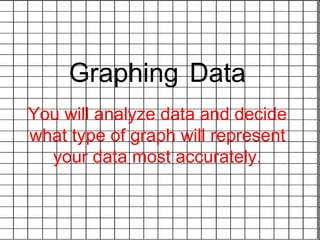Report
Share

More Related Content
What's hot
What's hot (20)
Types of graphs and charts and their uses with examples and pics

Types of graphs and charts and their uses with examples and pics
Viewers also liked
Viewers also liked (11)
Similar to Graphing Data
Similar to Graphing Data (20)
Top 8 Different Types Of Charts In Statistics And Their Uses

Top 8 Different Types Of Charts In Statistics And Their Uses
Understanding visual information:Figure, Graph, Table, and Diagram

Understanding visual information:Figure, Graph, Table, and Diagram
Statistical Graphics / Exploratory Data Analysis - DAY 2 - 8614 - B.Ed - AIOU

Statistical Graphics / Exploratory Data Analysis - DAY 2 - 8614 - B.Ed - AIOU
Basics of Educational Statistics (Graphs & its Types)

Basics of Educational Statistics (Graphs & its Types)
More from shas595
More from shas595 (20)
Recently uploaded
Driving Behavioral Change for Information Management through Data-Driven Gree...

Driving Behavioral Change for Information Management through Data-Driven Gree...Enterprise Knowledge
Recently uploaded (20)
ProductAnonymous-April2024-WinProductDiscovery-MelissaKlemke

ProductAnonymous-April2024-WinProductDiscovery-MelissaKlemke
Powerful Google developer tools for immediate impact! (2023-24 C)

Powerful Google developer tools for immediate impact! (2023-24 C)
From Event to Action: Accelerate Your Decision Making with Real-Time Automation

From Event to Action: Accelerate Your Decision Making with Real-Time Automation
Strategies for Landing an Oracle DBA Job as a Fresher

Strategies for Landing an Oracle DBA Job as a Fresher
IAC 2024 - IA Fast Track to Search Focused AI Solutions

IAC 2024 - IA Fast Track to Search Focused AI Solutions
Handwritten Text Recognition for manuscripts and early printed texts

Handwritten Text Recognition for manuscripts and early printed texts
Strategies for Unlocking Knowledge Management in Microsoft 365 in the Copilot...

Strategies for Unlocking Knowledge Management in Microsoft 365 in the Copilot...
Automating Google Workspace (GWS) & more with Apps Script

Automating Google Workspace (GWS) & more with Apps Script
Axa Assurance Maroc - Insurer Innovation Award 2024

Axa Assurance Maroc - Insurer Innovation Award 2024
Scaling API-first – The story of a global engineering organization

Scaling API-first – The story of a global engineering organization
Driving Behavioral Change for Information Management through Data-Driven Gree...

Driving Behavioral Change for Information Management through Data-Driven Gree...
How to Troubleshoot Apps for the Modern Connected Worker

How to Troubleshoot Apps for the Modern Connected Worker
The 7 Things I Know About Cyber Security After 25 Years | April 2024

The 7 Things I Know About Cyber Security After 25 Years | April 2024
Graphing Data
- 1. Graphing Data You will analyze data and decide what type of graph will represent your data most accurately.
- 4. All “parts” add up to 100%. A pie chart is shaped like a circle. It is divided into fractions that look like pieces of pie. Pie charts are best to use when you are trying to compare parts of a whole. They do not show changes over time.
- 5. A bar graph uses bars to show data. The bars can be vertical (up and down), or horizontal (across). Bar graphs are used to compare things between different groups.
- 7. A pictograph uses pictures or symbols to represent an assigned amount of data.
- 8. The Title The title offers a short explanation of what is in your graph. This helps the reader identify what they are about to look at. It can be creative or simple as long as it tells what is in the graph.
- 9. Y-Axis In line graphs, the y-axis runs vertically (up and down). Typically, the y-axis has numbers for the amount of “stuff” being measured. The y-axis usually starts at 0 and can be divided into as many equal parts as you want to.
- 10. X-Axis In line graphs the x-axis runs horizontally (flat). Typically, the x-axis has numbers representing different time periods or names of things being compared.
- 11. Typically, the independent variable is plotted on the x-axis and the dependent variable is plotted on the y-axis. Dependent Variable Independent Variable
- 13. The Key or Legend The legend tells what each line or bar represents. Just like on a map, the legend helps the reader understand what they are looking at.
- 14. Labels The x and y-axis need to be labeled so that the reader knows what is plotted on each axis.
- 15. How to number the x and y axis When numbering the axis, make sure to plan out how you will number the axis so that the range of numbers fit along the axis. Be sure to evenly space the numbers on each axis so that your data is accurately illustrated.